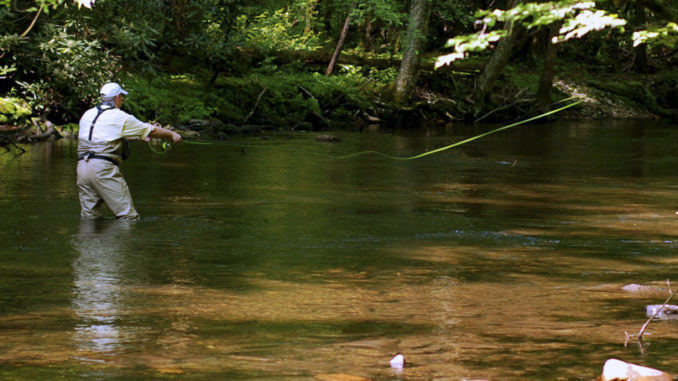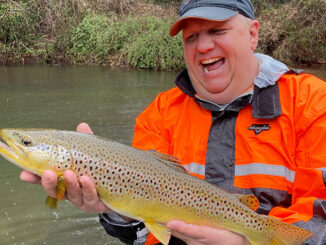
One of the most-famous streams in the east, Hazel Creek is worth the effort it takes to get there
No roads lead to one of the most-celebrated trout streams in the East. Isolated, remote, accessible only by boat or foot, Hazel Creek lives up to its reputation as a trout-fishing Mecca. It’s all that everyone says it is, and more.
From its confluence with Fontana Lake in the southwestern corner of North Carolina to its headwaters on the southwestern slope of Silers Bald, deep in the Great Smoky Mountains National Park, the stream is about 15 miles long. A gravel road follows the bank on much of the lower section. And a well-maintained and heavily traveled trail running along the creek offers access the rest of the way.
Named for the hazelnut shrubs that once grew along its banks, Hazel is a large creek. It’s bigger than some area rivers. And it contains good populations of wild rainbow and brown trout and a smaller population of brook trout in the higher waters around 4,000 feet above sea level. You can consistently catch rainbow trout in the 8- to 12-inch range. In the big pools, places such as the Brown Hole, anglers have caught brown trout up to 10 pounds.
Good fishing exists close to boat drop-off
A friend and I spent three days on the creek, expecting the best, yet prepared for disappointment. The fishing was far better than we anticipated.
Taking the ferry from Fontana Marina, we arrived at Hazel Creek about mid-afternoon on a Monday. We set up our base camp at Campsite No. 86 at Proctor, approximately one-half mile above the boat drop-off, and began fishing. We had been told at the marina that the trout were hitting hoppers, yellow Stimulators and Royal Wulffs. That’s what we used the entire trip.
Tuesday morning, we loaded up for a day trip to Bone Valley, about five miles above Proctor, a former town. This, we were told, is where the real fishing begins. We split up at Sugar Fork, the first tributary above Proctor, agreeing to meet around lunch time at the back-country campsite at Bone Valley. My friend went upstream on Hazel Creek, and I went upstream on Sugar Fork.
This area is loaded with trout
Sugar Fork was loaded with rainbows. After catching 20 or so trout, I stopped counting and just enjoyed the fishing. The trout were a bit smaller than the ones in Hazel Creek, averaging 6 to 8 inches. But they made up for their size in feistiness. Every pool, cascade, and run held a trout or two. After a couple of hours, my Royal Wulff was so ragged, I finally was forced to tie on a new fly.
My friend’s morning had been even more productive. He had caught, by his best guess, at least 60 fish, the largest one a 13-inch rainbow. After lunch, I fished Bone Valley Creek, another Hazel Creek tributary. Bone Valley was even better fishing than Sugar Fork. It offered a nice mix of medium-sized browns and rainbows. The biggest fish I caught in Bone Valley Creek was about 10 inches. Many of them measured 8 to 9 inches. And a slew of them were in the 4- to 6-inch range.
About 5:30 p.m., we headed back to Proctor, both of us bone-tired by the time we arrived. We had agreed we would have trout for dinner at least one night. So when we reached camp and rested a bit, we caught our dinner. It was the only time we killed trout on the trip.
Hazel Creek is sometimes quite crowded — but not always
On Wednesday, we fished upstream on the lower section of Hazel Creek. Fishing in the lower section is at best fair. It’s fished more often by day-trippers.
We had been warned to expect crowds, but we didn’t encounter many people. We had the campsite to ourselves two out of three nights. On the third day, two couples spent the night. At Bone Valley, we saw only three other fishers the entire day.
Once home only to the Cherokee, Hazel Creek was discovered by settlers around 1830. Around the turn of the century, copper was discovered, and Proctor enjoyed a short-lived boom. When the mines closed, loggers moved in, and Proctor mushroomed to a town of more than 1,000 people.
Hazel Creek is a treasure
After the lumber company moved out, so did many of the people. In 1942, the Tennessee Valley Authority began building Fontana Dam, the highest dam east of the Mississippi River. With the impoundment of Fontana Lake, the remaining residents of Hazel Creek were forced to leave. A few years later, Hazel Creek became part of the Great Smoky Mountains National Park, which ensures its protection for perpetuity.
That’s the way it should be. Hazel Creek is a treasure, isolated, remote, open to anyone willing to make an effort to get there. As for the fishing, nothing I’ve found equals it.
One if by land, two if by sea:
By foot, Hazel Creek can be reached by the Lakeshore Trail starting from Fontana Village or from Welch Ridge Trail where it joins the Appalachian Trail at Silers Bald near Clingmans Dome in the Great Smoky Mountains National Park. Either way is a long, strenuous hike. The easiest access is by boat, either from Fontana Marina or Cable Cove Campground. Fontana Marina has a daily ferry service to Hazel Creek. The boat ramp at Cable Cove offers free boat access. A back-country camping permit is required for overnight stays at designated campsites. Permits are available at the Oconaluftee Visitors Center at the entrance of the park near Cherokee, N.C. Either a North Carolina or Tennessee state fishing license is acceptable for trout fishing in the park. Fishing is limited to artificial lures or flies with a single hook. The daily creel limit is five fish, 7 inches or longer.





Be the first to comment